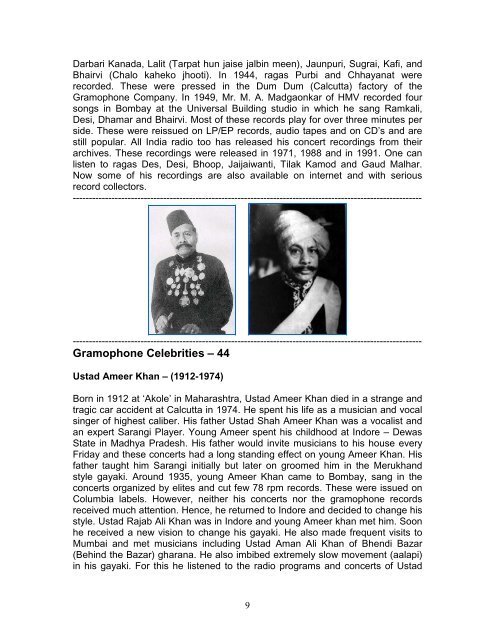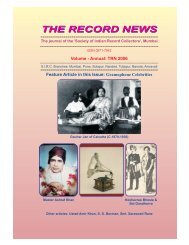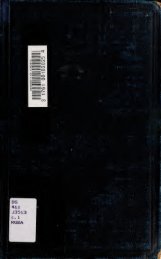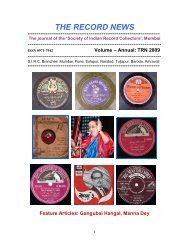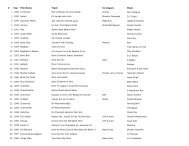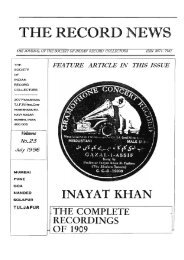THE RECORD NEWS - The Digital South Asia Library - University of ...
THE RECORD NEWS - The Digital South Asia Library - University of ...
THE RECORD NEWS - The Digital South Asia Library - University of ...
Create successful ePaper yourself
Turn your PDF publications into a flip-book with our unique Google optimized e-Paper software.
Darbari Kanada, Lalit (Tarpat hun jaise jalbin meen), Jaunpuri, Sugrai, Kafi, and<br />
Bhairvi (Chalo kaheko jhooti). In 1944, ragas Purbi and Chhayanat were<br />
recorded. <strong>The</strong>se were pressed in the Dum Dum (Calcutta) factory <strong>of</strong> the<br />
Gramophone Company. In 1949, Mr. M. A. Madgaonkar <strong>of</strong> HMV recorded four<br />
songs in Bombay at the Universal Building studio in which he sang Ramkali,<br />
Desi, Dhamar and Bhairvi. Most <strong>of</strong> these records play for over three minutes per<br />
side. <strong>The</strong>se were reissued on LP/EP records, audio tapes and on CD’s and are<br />
still popular. All India radio too has released his concert recordings from their<br />
archives. <strong>The</strong>se recordings were released in 1971, 1988 and in 1991. One can<br />
listen to ragas Des, Desi, Bhoop, Jaijaiwanti, Tilak Kamod and Gaud Malhar.<br />
Now some <strong>of</strong> his recordings are also available on internet and with serious<br />
record collectors.<br />
------------------------------------------------------------------------------------------------------------<br />
------------------------------------------------------------------------------------------------------------<br />
Gramophone Celebrities – 44<br />
Ustad Ameer Khan – (1912-1974)<br />
Born in 1912 at ‘Akole’ in Maharashtra, Ustad Ameer Khan died in a strange and<br />
tragic car accident at Calcutta in 1974. He spent his life as a musician and vocal<br />
singer <strong>of</strong> highest caliber. His father Ustad Shah Ameer Khan was a vocalist and<br />
an expert Sarangi Player. Young Ameer spent his childhood at Indore – Dewas<br />
State in Madhya Pradesh. His father would invite musicians to his house every<br />
Friday and these concerts had a long standing effect on young Ameer Khan. His<br />
father taught him Sarangi initially but later on groomed him in the Merukhand<br />
style gayaki. Around 1935, young Ameer Khan came to Bombay, sang in the<br />
concerts organized by elites and cut few 78 rpm records. <strong>The</strong>se were issued on<br />
Columbia labels. However, neither his concerts nor the gramophone records<br />
received much attention. Hence, he returned to Indore and decided to change his<br />
style. Ustad Rajab Ali Khan was in Indore and young Ameer khan met him. Soon<br />
he received a new vision to change his gayaki. He also made frequent visits to<br />
Mumbai and met musicians including Ustad Aman Ali Khan <strong>of</strong> Bhendi Bazar<br />
(Behind the Bazar) gharana. He also imbibed extremely slow movement (aalapi)<br />
in his gayaki. For this he listened to the radio programs and concerts <strong>of</strong> Ustad<br />
9


